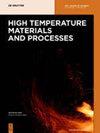微波烧结制备NbC-Ni陶瓷的显微结构和力学性能
IF 1.5
4区 材料科学
Q4 MATERIALS SCIENCE, MULTIDISCIPLINARY
引用次数: 4
摘要
摘要本研究展示了微波烧结(MS)在制备NbC-10Ni和NbC-12Ni陶瓷中的应用,以及对其显微组织、相形成和力学性能的影响。结果表明,用质谱法可以在较短的时间内得到结构均匀、精细的NbC-Ni陶瓷。烧结温度对NbC-Ni陶瓷的微观结构和力学性能影响较大,而保温时间的影响相对较小。随着烧结温度的升高,NbC-Ni陶瓷的显微组织经历了烧结致密化和晶粒长大。强度、韧性随烧结温度的升高先升高后降低,硬度随烧结温度的升高而升高。根据综合力学性能,优化的烧结工艺为1390℃,保温时间为15 min。此时,没有新相形成,但Ni的衍射峰发生了相移。通过分析发现,NbC-Ni陶瓷综合力学性能的改善机制主要包括晶粒细化、裂纹挠曲和桥接以及Ni韧性相的能量吸收。本文章由计算机程序翻译,如有差异,请以英文原文为准。
Microstructure and mechanical properties of NbC–Ni cermets prepared by microwave sintering
Abstract This study shows the application of microwave sintering (MS) on preparing NbC–10Ni and NbC–12Ni cermets, as well as the effect of its microstructure, phase formation, and mechanical properties. Results indicated that NbC–Ni cermets with a fine and uniform structure can be obtained by MS in a relatively short time. And the sintering temperature greatly influenced the microstructure and mechanical properties of NbC–Ni cermets, whereas the effect of dwell time is relatively small. With the increase of the sintering temperature, the microstructure of NbC–Ni cermets experienced sintering densification and grain growth. The strength and toughness increased first and then decreased, and the hardness increased with the increase of sintering temperature. According to the comprehensive mechanical properties, the optimized sintering process is 1,390°C and the dwell time is 15 min. At this time, no new phase formed, but the diffraction peak of the Ni phase shifted. Through analysis, it is found that the improvement mechanisms for comprehensive mechanical properties of NbC–Ni cermets mainly include grain refinement, crack deflection and bridging, and energy absorption of the ductile phase of Ni.
求助全文
通过发布文献求助,成功后即可免费获取论文全文。
去求助
来源期刊

High Temperature Materials and Processes
工程技术-材料科学:综合
CiteScore
2.50
自引率
0.00%
发文量
42
审稿时长
3.9 months
期刊介绍:
High Temperature Materials and Processes offers an international publication forum for new ideas, insights and results related to high-temperature materials and processes in science and technology. The journal publishes original research papers and short communications addressing topics at the forefront of high-temperature materials research including processing of various materials at high temperatures. Occasionally, reviews of a specific topic are included. The journal also publishes special issues featuring ongoing research programs as well as symposia of high-temperature materials and processes, and other related research activities.
Emphasis is placed on the multi-disciplinary nature of high-temperature materials and processes for various materials in a variety of states. Such a nature of the journal will help readers who wish to become acquainted with related subjects by obtaining information of various aspects of high-temperature materials research. The increasing spread of information on these subjects will also help to shed light on relevant topics of high-temperature materials and processes outside of readers’ own core specialties.
 求助内容:
求助内容: 应助结果提醒方式:
应助结果提醒方式:


